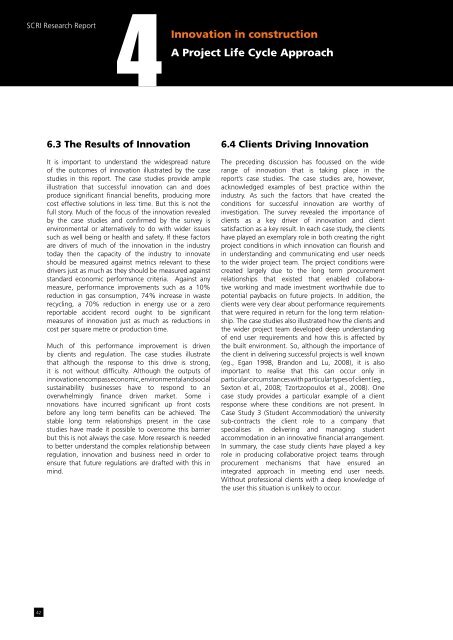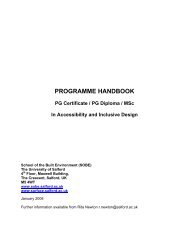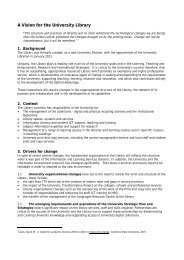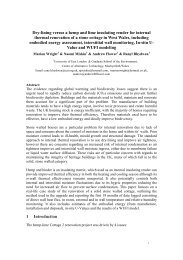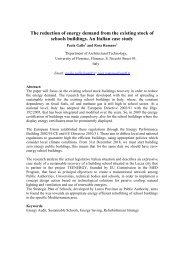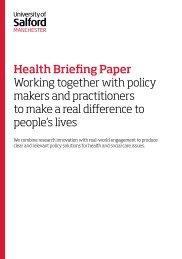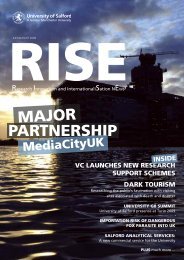Innovation in Construction A Project Life Cycle Approach
Innovation in Construction A Project Life Cycle Approach
Innovation in Construction A Project Life Cycle Approach
Create successful ePaper yourself
Turn your PDF publications into a flip-book with our unique Google optimized e-Paper software.
SCRI Research Report4<strong>Innovation</strong> <strong>in</strong> constructionA <strong>Project</strong> <strong>Life</strong> <strong>Cycle</strong> <strong>Approach</strong>6.3 The Results of <strong>Innovation</strong>It is important to understand the widespread natureof the outcomes of <strong>in</strong>novation illustrated by the casestudies <strong>in</strong> this report. The case studies provide ampleillustration that successful <strong>in</strong>novation can and doesproduce significant f<strong>in</strong>ancial benefits, produc<strong>in</strong>g morecost effective solutions <strong>in</strong> less time. But this is not thefull story. Much of the focus of the <strong>in</strong>novation revealedby the case studies and confirmed by the survey isenvironmental or alternatively to do with wider issuessuch as well be<strong>in</strong>g or health and safety. If these factorsare drivers of much of the <strong>in</strong>novation <strong>in</strong> the <strong>in</strong>dustrytoday then the capacity of the <strong>in</strong>dustry to <strong>in</strong>novateshould be measured aga<strong>in</strong>st metrics relevant to thesedrivers just as much as they should be measured aga<strong>in</strong>ststandard economic performance criteria. Aga<strong>in</strong>st anymeasure, performance improvements such as a 10%reduction <strong>in</strong> gas consumption, 74% <strong>in</strong>crease <strong>in</strong> wasterecycl<strong>in</strong>g, a 70% reduction <strong>in</strong> energy use or a zeroreportable accident record ought to be significantmeasures of <strong>in</strong>novation just as much as reductions <strong>in</strong>cost per square metre or production time.Much of this performance improvement is drivenby clients and regulation. The case studies illustratethat although the response to this drive is strong,it is not without difficulty. Although the outputs of<strong>in</strong>novation encompass economic, environmental and socialsusta<strong>in</strong>ability bus<strong>in</strong>esses have to respond to anoverwhelm<strong>in</strong>gly f<strong>in</strong>ance driven market. Some <strong>in</strong>novations have <strong>in</strong>curred significant up front costsbefore any long term benefits can be achieved. Thestable long term relationships present <strong>in</strong> the casestudies have made it possible to overcome this barrierbut this is not always the case. More research is neededto better understand the complex relationship betweenregulation, <strong>in</strong>novation and bus<strong>in</strong>ess need <strong>in</strong> order toensure that future regulations are drafted with this <strong>in</strong>m<strong>in</strong>d.6.4 Clients Driv<strong>in</strong>g <strong>Innovation</strong>The preced<strong>in</strong>g discussion has focussed on the widerange of <strong>in</strong>novation that is tak<strong>in</strong>g place <strong>in</strong> thereport’s case studies. The case studies are, however,acknowledged examples of best practice with<strong>in</strong> the<strong>in</strong>dustry. As such the factors that have created theconditions for successful <strong>in</strong>novation are worthy of<strong>in</strong>vestigation. The survey revealed the importance ofclients as a key driver of <strong>in</strong>novation and clientsatisfaction as a key result. In each case study, the clientshave played an exemplary role <strong>in</strong> both creat<strong>in</strong>g the rightproject conditions <strong>in</strong> which <strong>in</strong>novation can flourish and<strong>in</strong> understand<strong>in</strong>g and communicat<strong>in</strong>g end user needsto the wider project team. The project conditions werecreated largely due to the long term procurementrelationships that existed that enabled collaborativework<strong>in</strong>g and made <strong>in</strong>vestment worthwhile due topotential paybacks on future projects. In addition, theclients were very clear about performance requirementsthat were required <strong>in</strong> return for the long term relationship.The case studies also illustrated how the clients andthe wider project team developed deep understand<strong>in</strong>gof end user requirements and how this is affected bythe built environment. So, although the importance ofthe client <strong>in</strong> deliver<strong>in</strong>g successful projects is well known(eg., Egan 1998, Brandon and Lu, 2008), it is alsoimportant to realise that this can occur only <strong>in</strong>particular circumstances with particular types of client (eg.,Sexton et al., 2008; Tzortzopoulos et al., 2008). Onecase study provides a particular example of a clientresponse where these conditions are not present. InCase Study 3 (Student Accommodation) the universitysub-contracts the client role to a company thatspecialises <strong>in</strong> deliver<strong>in</strong>g and manag<strong>in</strong>g studentaccommodation <strong>in</strong> an <strong>in</strong>novative f<strong>in</strong>ancial arrangement.In summary, the case study clients have played a keyrole <strong>in</strong> produc<strong>in</strong>g collaborative project teams throughprocurement mechanisms that have ensured an<strong>in</strong>tegrated approach <strong>in</strong> meet<strong>in</strong>g end user needs.Without professional clients with a deep knowledge ofthe user this situation is unlikely to occur.42


